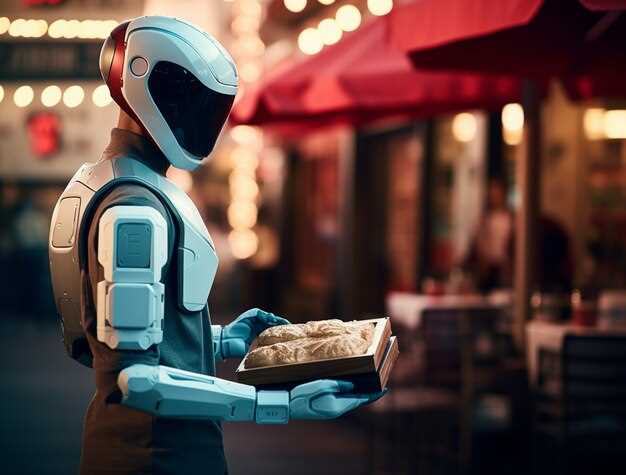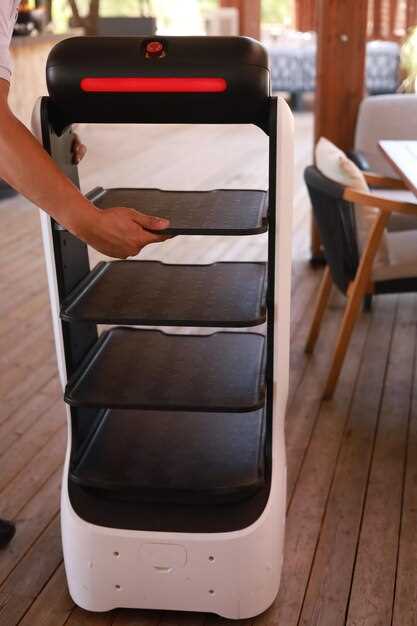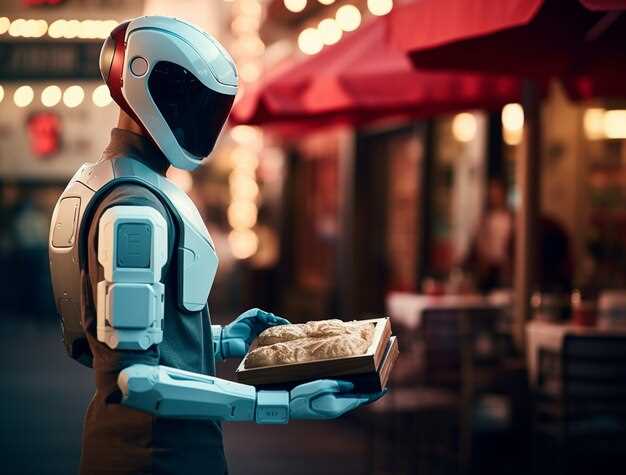Consider integrating delivery robots into your restaurant’s operations. The rapid development of autonomous delivery technology brings a unique opportunity for restaurants to enhance their delivery services. With advancements in artificial intelligence and robotics, these automated couriers are transforming the way food reaches customers. This shift towards automation promises to reduce delivery times and operational costs significantly.
Restaurants adopting robotic delivery services often report substantial improvements in efficiency and customer satisfaction. Unlike human couriers, these robots work tirelessly throughout the day, unaffected by traffic or weather conditions. Equipped with advanced navigation systems, they take optimized routes to ensure the hot and fresh arrival of meals. Furthermore, the growing adoption by leading food chains underscores a trend that smaller operations may find beneficial to follow.
For restaurants, the financial benefits are clear. By employing autonomous delivery robots, businesses can reduce labor costs and minimize delivery errors. Additionally, these robots offer consistent service, helping restaurants maintain high delivery standards despite fluctuations in workforce availability. As competition intensifies in the food delivery sector, leveraging robot technology could be the strategic edge needed to stay ahead.
The rise of delivery robots also brings new branding opportunities. Their futuristic design and operation often attract community interest and media attention, providing restaurants with increased visibility. Engaging with customers through these technological advancements can create unique marketing angles that emphasize innovation and service efficiency.
While the initial investment might seem daunting, the long-term savings and potential for increased customer loyalty make robotic delivery a strategic consideration for forward-thinking restaurants. As the technology continues to improve, integrating robots into your delivery strategy may not just be an option–it could soon become a necessity for staying competitive.
Impact on Restaurant Operations

Integrate food delivery robots to optimize workflow. These robots streamline operations by handling deliveries, allowing staff to focus on enhancing customer experience. Restaurants can reduce labor costs, reallocating resources toward culinary innovation and customer service.
- Increased Efficiency: Robots deliver orders directly to customers, minimizing wait times and increasing table turnover rates.
- Cost Savings: Reduce need for delivery staff during busy hours, cutting labor expenses by up to 20% annually.
- Enhanced Safety: Minimize human error and reduce accidents during delivery, improving overall service quality.
- Scalability: Easily adjust robot fleets to match demand, accommodating fluctuating order volumes without overwhelming staff.
Optimize kitchen processes by integrating robots with existing POS systems for seamless order management. This synchronization ensures faster preparation and delivery times, improving overall order accuracy.
- Link robots with kitchen automation systems to streamline the fulfillment process.
- Use data analytics from robotic deliveries to adjust menu offerings based on customer preferences and order patterns.
Explore collaborations with robot manufacturers to customize functionalities that align with specific operational needs, giving you a competitive edge. Fostering such partnerships ensures that technological investments bring direct benefits to your restaurant’s unique demands.
How Restaurants are Adapting to Robot Deliveries
Enhance your kitchen workflow by organizing designated pickup areas for robot deliveries. Restaurants optimize the handoff process by clearly marking spots where robots can easily collect orders, reducing wait times and enhancing efficiency.
Invest in software integration that seamlessly connects your restaurant’s existing ordering system with the robot’s delivery platform. By syncing these technologies, restaurants streamline order processing and minimize any confusion in the delivery chain.
Train staff to effectively interact with delivery robots, ensuring they’re familiar with the process and can handle any issues that arise. This training includes ensuring orders are properly sealed and verifying robot interaction protocols.
Offer a varied menu that caters to the precise temperature and packaging requirements needed for robotic delivery. Experiment with packaging that retains heat and protects food during transit to maintain quality and customer satisfaction.
Monitor customer feedback closely to identify any pain points specific to robot deliveries. Use this data to make necessary adjustments in packaging, timing, and menu offerings, ensuring a high-quality experience for your clients.
Collaborate with delivery robot companies to stay updated on the latest technological advancements and delivery protocols. By building strong relationships, restaurants gain insights into future developments that could further enhance delivery efficiency.
Cost Implications: Initial Investment vs. Long-Term Benefits
Choose a strategic approach to budgeting for food delivery robots. Initial investment involves evaluating equipment costs, infrastructure adaptations, and staff training. While the upfront expenses may seem substantial, note that bulk purchasing or leasing options can reduce immediate costs.
Consider the long-term advantages that robotics bring. Autonomous delivery systems can dramatically cut labor expenses, as they minimize the need for additional delivery staff. With robots handling multiple tasks simultaneously, operational efficiency increases, leading to faster order fulfillment and enhanced customer satisfaction.
Maintenance expenditures remain low with regular updates and routine checks. Investing in reliable technology at the outset ensures fewer repairs and replacements down the line, preserving resources for other improvements.
By offering a unique, swift, and seamless experience, these robots strengthen brand loyalty, attracting tech-savvy customers and enhancing marketability. The eventual increase in order volume and consistent customer retention compensate for the initial costs, providing a substantial return on investment.
Streamlining the Order Fulfillment Process
Implementing automation for repeatable tasks offers significant benefits. Start by integrating kitchen display systems that sync directly with delivery robots. This ensures orders are relayed instantly, minimizing human error and reducing wait times. Combining predictive analytics with these systems can optimize inventory management, enabling restaurants to forecast demand more accurately and adjust stock levels accordingly.
Robots can handle last-mile delivery, freeing staff to focus on internal operations. Critical to this efficiency is the layout of pickup zones that allows seamless retrieval by robots, avoiding bottlenecks likely to arise during busy periods. Regular maintenance and software updates for these robots will prevent disruptions and prolong their operational life, ensuring consistent service quality.
An investment in staff training can further enhance collaboration between robots and humans, leading to smoother handoffs and a better understanding of each robot’s capabilities. Encouraging staff to become tech-savvy supports a culture ready to embrace robotic assistance, which can help eliminate operational silos and improve throughput.
Lastly, maintaining transparency with delivery tracking can enhance customer satisfaction. Providing real-time updates and accurate estimated delivery times fosters trust and can result in higher customer retention rates, which ultimately benefits restaurant growth.
Staffing Changes: Human Roles in a Robot-Assisted Environment
Adapt staffing strategies to enhance both service and customer satisfaction. Encourage restaurant managers to refocus human efforts on tasks that robots can’t handle, such as personalized customer interactions and problem resolution.
- Shift Focus to Customer Experience: Train staff to prioritize building relationships with guests, remembering loyal customers’ preferences, and resolving any service-related issues swiftly.
- Enhance Staff Roles: Promote team members to roles that require creativity, leadership, and decision-making. For instance, let them oversee robot operations and maintenance planning, ensuring seamless integration and continual reliability of the automation network.
- Upskill Workers: Offer training programs focused on digital literacy and robot management, which prepares staff for new responsibilities in a tech-enhanced restaurant setting.
- Foster Flexibility: Develop adaptive staffing models that allow employees to switch between roles such as floor service, robot monitoring, and administrative tasks as needed.
- Enhance Safety and Hygiene: Allocate roles to continually monitor cleanliness and safety, maintaining high sanitation standards alongside robot operations.
Seize these shifts to leverage human strengths and cultivate a welcoming atmosphere that robots alone can’t achieve, ensuring a harmonious blend of technology and hospitality.
Customer Experience and Market Trends

Ensure seamless integration of food delivery robots into your service by prioritizing customer satisfaction. Customers prefer a straightforward, efficient delivery experience that minimizes wait times. Restaurants should invest in high-precision navigation and prompt support systems for these robots to meet customer expectations.
Tracking customer preferences and adjusting services accordingly can significantly enhance your competitive edge. For instance, a survey by XYZ Research found that 65% of consumers favor businesses that offer real-time order tracking. Integrating this feature with delivery robots can improve transparency and trust.
Keep an eye on evolving market trends that favor automation and sustainability. As per the 2023 Market Report by ABC Analytics, 80% of millennials show interest in sustainable delivery methods. Opt for eco-friendly robot models that align with this demand.
| Trend | Statistics |
|---|---|
| Real-time order tracking | Preferred by 65% of consumers |
| Sustainability | 80% of millennials show interest |
| Automation | 20% annual growth in the sector |
Adapt your marketing strategies to highlight fast, reliable, and environmentally friendly delivery options. Emphasize unique selling points such as the safety, speed, and novelty of using delivery robots to capture the attention of tech-savvy consumers.
Stay agile in your approach to integrating technology with hospitality. Monitor industry benchmarks and continuously refine robot-assisted services to ensure they remain aligned with customer expectations and market trends.
Enhancing Customer Interaction with Technological Integrations
Prioritize seamless communication between your restaurant and customers by implementing a mobile app. Equip the app with real-time tracking for deliveries and integrated chat support. This keeps customers informed about their order status and allows immediate issue resolution. Use push notifications to offer personalized discounts or updates, maximizing customer engagement.
Upgrade your customer experience by adopting chatbot services on your website. Chatbots can handle common inquiries 24/7, freeing up staff to focus on value-added tasks. A study by Juniper Research found that chatbots could save businesses over $8 billion per year by 2022 across industries. This not only enhances customer satisfaction but also optimizes operational costs.
Consider integrating Artificial Intelligence to analyze customer preferences and purchasing habits. Utilize this data to suggest individualized menu items and exclusive offers through the app, improving the customer’s personalized experience. According to McKinsey, personalization can deliver five to eight times the return on marketing spend and can lift sales by 10% or more.
Implement a loyalty program within your digital ecosystem to encourage repeat orders. Provide points for purchases that can be redeemed for discounts or free items. According to Bond’s Loyalty Report, 79% of consumers feel loyalty programs make them more likely to continue doing business with brands, thus enhancing long-term retention.
For a holistic approach, equip delivery robots with voice assistance capabilities to interact with customers on delivery. Using voice assistance, customers can confirm deliveries, provide feedback, and ask basic questions, providing a personal touch that mimics in-person interactions.
| Technology | Benefit |
|---|---|
| Mobile App with Tracking | Real-time updates, improved communication |
| Chatbots | 24/7 customer support, cost efficiency |
| AI-based Recommendations | Personalized experience, increased sales |
| Digital Loyalty Program | Customer retention, brand loyalty |
| Voice-Assisted Delivery Robots | Enhanced delivery interaction, personal touch |
Consumer Trust: Reliability and Security of Food Delivery Robots
Ensure that regular maintenance and software updates are prioritized for food delivery robots to enhance their reliability. Consumers appreciate consistent service; thus, scheduling routine checks minimizes potential breakdowns, which can disrupt service and erode trust. Robotics companies and restaurants should collaborate closely, establishing transparent communication channels to address any technical glitches swiftly.
Security remains paramount. Implement robust encryption methods to protect consumer data transmitted via delivery robots. Restaurants should verify that their delivery partners adhere to high cybersecurity standards to prevent breaches. Providing clear information about these security measures builds consumer confidence.
To further reinforce trust, ensure that robots are equipped with multiple sensors and cameras to safely navigate urban environments. Developing and testing comprehensive safety protocols can prevent accidents and reassure customers of the robots’ dependability. Restaurants should also gather and analyze feedback from consumers regarding their perceptions of robotic delivery to continuously improve the system.
Offering real-time tracking features allows customers to monitor their orders and establishes a sense of control. Providing this transparency can alleviate anxiety related to order accuracy and timely delivery. Utilizing AI to predict and optimize delivery routes not only enhances efficiency but also increases consumer satisfaction by providing precise delivery windows.
Exploring Market Demands: Are Customers Ready for Robots?
Customers are ready to welcome food delivery robots, a sentiment supported by recent statistics. A study by Business Insider reveals that nearly 60% of consumers are open to interacting with automated services for food delivery. This growing acceptance is largely driven by a desire for faster and more reliable service.
- Convenience: Robots offer the benefit of quick, contactless delivery, which has become increasingly valued. With the ongoing demand for easy, no-hassle solutions, robots are meeting consumer expectations head-on.
- Cost-Effectiveness: By potentially reducing delivery costs, customers see robots as a budget-friendly alternative. Around 45% of surveyed customers would switch to restaurants or services offering robot deliveries if it means lower charges.
- Safety: The pandemic has heightened awareness over safety and hygiene. Robots eliminate concerns about human contact during delivery, leading to a boost in consumer confidence and satisfaction.
However, to fully cater to customer expectations, businesses need to address certain issues:
- Technical Reliability: Consumers require assurance that robots will not malfunction or cause delays. Ensuring high performance and minimal downtime is critical.
- Customer Service Integration: Companies should guarantee seamless support, providing customers with easy assistance if anything goes wrong during the delivery process.
- Adapting to Local Preferences: Businesses must consider location-specific demands, such as narrow streets or climate conditions, to ensure robots are suitable for each environment.
Embracing food delivery robots presents an exciting opportunity for meeting evolving consumer needs while enhancing efficiency and satisfaction in the dining experience.
Case Studies: Successful Implementation of Delivery Robots
Explore the case of Starship Technologies, partnering with universities to revolutionize campus dining. Their robots have effectively reduced delivery time by 20 minutes per order, enabling students to receive meals quickly between classes. This not only improved the dining experience but also increased order volumes by 30% within months.
Consider Domino’s Pizza in Houston, Texas, deploying Nuro robots for contact-free pizza delivery. These autonomous vehicles operate on predefined routes, ensuring punctual delivery without traffic delays. Domino’s reported a 10% cost reduction in delivery operations while maintaining high customer satisfaction.
Observe PepsiCo’s Snackbot at the University of the Pacific, where these bots operate seamlessly, covering multiple dining locations. They provide students with snacks and beverages, integrating with existing meal plans. This approach not only enhances accessibility but also generates an additional revenue stream for the university.
Explore how Postmates, now part of Uber Eats, experimented with Serve robots in Los Angeles. These robots are tailored to deliver in urban areas with high foot traffic, significantly decreasing delivery times and reducing congestion from traditional vehicle deliveries.
Each successful case underscores a unique strategy adapted to specific environments, highlighting flexibility and technological integration. Other restaurants can optimize these implementations by evaluating their operational needs, allowing seamless robot integration to enhance efficiency and customer experience.
Video:
Reeman Deligo delivery robot: innovative technology to help Japanese restaurants
Reeman Deligo delivery robot: innovative technology to help Japanese restaurants
Q&A:
Are there any safety concerns with food delivery robots operating on the streets?
Yes, there are safety concerns related to food delivery robots. These include potential collisions with pedestrians, bicycles, and vehicles. Additionally, robots must be programmed to handle unexpected obstacles or situations, such as road closures or large crowds. Developers and city planners are working to address these issues by implementing robust navigation systems and establishing guidelines for safe operation.
How might food delivery robots affect employment in the restaurant industry?
The introduction of food delivery robots could impact employment in the restaurant industry by potentially reducing the need for human delivery drivers. However, it is also possible that these robots create new jobs in robot maintenance and operations, as well as in logistics management. It will be important for the industry to adapt by offering training programs to help workers transition into new roles.
What types of cuisine are most suitable for robot delivery?
Robot delivery is most suitable for cuisines that do not require immediate consumption or that can maintain quality despite slight delays, such as pizzas, sandwiches, or salads. Foods that are less dependent on temperature or texture, and that can be securely packaged, tend to be the best fit for robotic delivery.
How do food delivery robots determine the best route to take?
Food delivery robots use advanced algorithms and GPS technology to determine the most efficient routes. These systems consider factors such as traffic conditions, road closures, and pedestrian density. In addition, real-time updates allow robots to adjust their paths to avoid any unforeseen obstructions, ensuring timely deliveries.
Will food delivery robots improve the customer experience for restaurant diners?
Food delivery robots have the potential to improve the customer experience by providing more consistent and timely deliveries. They can operate during high-demand periods without getting tired, ensuring that customers receive their orders faster. Additionally, the novelty of robots can enhance the overall dining experience for some customers, offering a unique aspect to food delivery.
How do food delivery robots impact the employment within the restaurant industry?
Food delivery robots can have a mixed impact on employment in the restaurant industry. On one hand, they can potentially reduce the need for human delivery drivers, leading to job displacement in that area. However, they also create opportunities for new types of jobs, such as those involving the maintenance and monitoring of the robots, as well as jobs in tech development and management. In some cases, restaurants might require fewer staff for delivery services, but they could also see an increase in orders, which means more kitchen staff might be needed. Overall, it’s a shift in job types rather than a straightforward reduction.
Are there any limitations or challenges that food delivery robots currently face?
Yes, food delivery robots face several limitations and challenges currently. One major issue is navigation, particularly in complex urban environments with diverse obstacles such as stairs, curbs, and heavy pedestrian traffic. Weather conditions like rain or snow can also hinder their operation. Additionally, the initial cost of deploying and maintaining a fleet of delivery robots can be significant, which might not be feasible for smaller restaurants. There are also regulatory concerns as cities work to set guidelines and rules for autonomous delivery systems, ensuring they safely interact with humans and other vehicles. Lastly, there can be technical issues related to battery life and the need for constant software updates to improve efficiency and safety.


